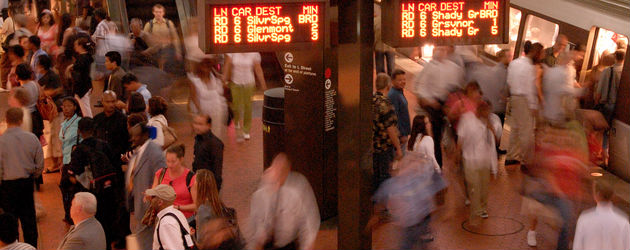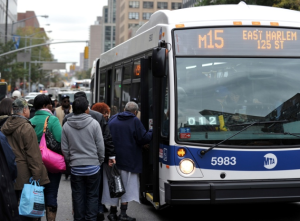Record 10.5 Billion Trips on U.S. Public Transport in 2012
 The demand for public transportation rose last year as Americans took 10.5 billion trips, the second highest ridership since 1957, and 154 million more trips than the previous year, according to a report released today by the American Public Transportation Association (APTA).
The demand for public transportation rose last year as Americans took 10.5 billion trips, the second highest ridership since 1957, and 154 million more trips than the previous year, according to a report released today by the American Public Transportation Association (APTA).
This was the seventh year in a row that more than 10 billion trips were taken on public transportation systems nationwide.
“In 2012, U.S. public transportation ridership grew at a record level as Americans took 10.5 billion trips. This is the second highest ridership since 1957, and it shows that there is a growing demand for public transportation,” said APTA President and CEO Michael Melaniphy. “Every mode of public transportation showed an increase in ridership. Public transit ridership grew in all areas of the country – north, south, east, and west — in small, medium and large communities, with at least 16 public transit systems reporting record ridership.”
 “Considering the devastating impact of Hurricane Sandy on some of the nation’s largest systems, this record level of ridership is truly significant,” said Melaniphy.
“Considering the devastating impact of Hurricane Sandy on some of the nation’s largest systems, this record level of ridership is truly significant,” said Melaniphy.
According to APTA, 74 million trips were lost when public transit systems from Washington, D.C. to Boston were shut down due to Hurricane Sandy and the blizzard that followed the next week.
“Two big reasons for the increased national transit ridership are high, volatile gas prices and in certain localities, a recovering economy with more people returning to work,” said Melaniphy. “Public transportation saves people money, and people save even more so when gas prices spike. Also, since nearly 60 percent of trips taken on public transportation are for work commutes, it makes sense that ridership increases in areas where the economy has improved and new jobs have been added.”
Noting that people are changing their attitudes regarding travel, Melaniphy said, “There is a sea change going on in the way that people look at transportation. Americans want travel choices; they want to be able to choose the best travel option for their lives. This is an exciting time for the public transportation industry as more and more Americans support it and want it.”
Melaniphy also pointed out that more Americans are supporting public transportation investment, as evidenced by the large number of transit-oriented ballot initiatives that passed in 2012. “Last year 49 out of 62 transit-oriented state and local ballot initiatives passed,” said Melaniphy. “That means there was a nearly 80 percent passage rate. This extremely high rate of success demonstrates how important public transportation is to people and to communities.”
To see the complete APTA 2012 ridership report, go to: http://www.apta.com/resources/statistics/Documents/Ridership/2012-q4-ridership-APTA.pdf
2012 Ridership Breakdown
Light rail (modern streetcars, trolleys, and heritage trolleys) ridership increased 4.5 percent in 2012 with 21 out of 28 transit systems reporting increases. With a new rail line extension that opened in August 2011, the light rail in Hampton, VA saw an increase of 154%. Systems that showed double digit increases in 2012 were located in the following cities: Memphis, TN (28.4%); Dallas, TX (20.8%); Los Angeles, CA (18.5%); Salt Lake City, UT (14.7%); Pittsburgh, PA (14.7%); and Seattle, WA – Sound Transit (10.7%). Ridership in the following cities also saw increases at or above five percent: Sacramento, CA (7.1%); Phoenix, AZ (6.7%); and Houston, TX (5.8%), Seattle, WA – King County Dept. of Transportation (5.0%). Heavy rail (subways and elevated trains) ridership increased by 1.4 percent across the country as 10 out of 15 transit systems reported increases.
Heavy rail systems with the largest increases in ridership for 2012 were in the following cities: Cleveland, OH (9.7%); San Francisco, CA (7.8%); Miami, FL (5.2%); Chicago, IL (4.3%); and Los Angeles, CA (3.7%).
 Nationally, commuter rail ridership increased by 0.5 percent in 2012 as 18 out of 28 transit systems reported increases. With a new rail line extension that opened in June 2011, the commuter rail in Lewisville, TX, saw an increase of 97.3%. The following five commuter rail systems saw double digit increases in 2012: Austin, TX (26.8%); Salt Lake City, UT (14.7%); Stockton, CA (14.0%); San Carlos, CA (13.0%); and Seattle, WA (10.5%). Other cities with increases above five percent were: Portland, OR (8.2%); Portland, ME (7.1%), Baltimore, MD (6.6%); Harrisburg-Philadelphia, PA (5.7%); and Los Angeles, CA (5.2%).
Nationally, commuter rail ridership increased by 0.5 percent in 2012 as 18 out of 28 transit systems reported increases. With a new rail line extension that opened in June 2011, the commuter rail in Lewisville, TX, saw an increase of 97.3%. The following five commuter rail systems saw double digit increases in 2012: Austin, TX (26.8%); Salt Lake City, UT (14.7%); Stockton, CA (14.0%); San Carlos, CA (13.0%); and Seattle, WA (10.5%). Other cities with increases above five percent were: Portland, OR (8.2%); Portland, ME (7.1%), Baltimore, MD (6.6%); Harrisburg-Philadelphia, PA (5.7%); and Los Angeles, CA (5.2%).
Large bus systems reported an increase of 1 percent nationally, and 29 out of 38 large bus systems reported increases. Large bus systems with the increases above four percent were located in the following areas: Saint Louis, MO (7.1%); Providence, RI (6.2%); Arlington Heights, IL (4.9%); Seattle, WA – King County DOT (4.6%); Fort Lauderdale, FL (4.3%); Dallas, TX (4.3%), and Long Beach, CA (4.2%).
Demand response (paratransit) ridership increased in 2012 by 4.5 percent and trolleybus ridership increased by .24 percent.
Below is a sampling of 2012 record ridership that occurred on public transit nationwide.
Ann Arbor, MI – Ann Arbor Transportation Authority
Boston, MA – Massachusetts Bay Transportation Authority
Canton, OH – Stark Area Regional Transit Authority
Champaign, IL – Champaign Urbana Mass Transit District
Charleston, SC – Charleston Area Regional Transportation Authority
Lewisville, TX – Denton County Transportation Authority
Minneapolis, MN – Metro Transit
Nashville, TN – Metropolitan Transit Authority
Olympia, WA – Intercity Transit
Orlando, FL – Central Florida Regional Transportation Authority
Phoenix, AZ – Valley Metro
Pompano Beach, FL – South Florida Regional Transportation Authority – (2nd highest ridership ever)
Riverside, CA – Riverside Transit Agency
St. Petersburg, FL – Pinellas Suncoast Transit Authority
San Bernardo, CA – Omnitrans
Seattle, WA – Sound Transit
# # #
The American Public Transportation Association (APTA) is a nonprofit international association of 1,500 public and private sector organizations, engaged in the areas of bus, paratransit, light rail, commuter rail, subways, waterborne services, and intercity and high-speed passenger rail. This includes: transit systems; planning, design, construction, and finance firms; product and service providers; academic institutions; transit associations and state departments of transportation. APTA is the only association in North America that represents all modes of public transportation. APTA members serve the public interest by providing safe, efficient and economical transit services and products More than 90 percent of the people using public transportation in the United States and Canada ride APTA member systems.
Category: General Update, Transit News









